Offshore Windparks
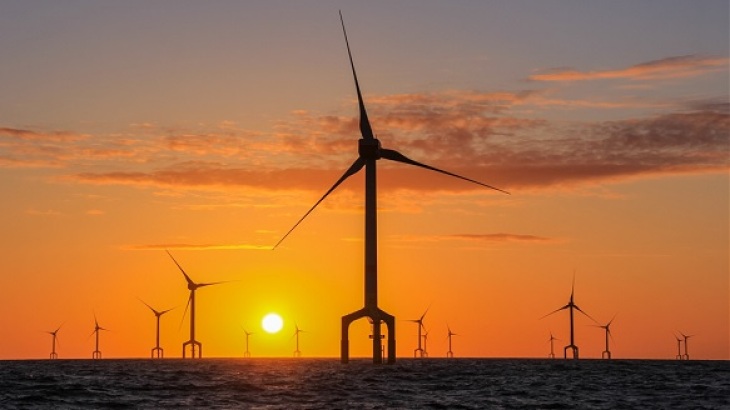
Wind farm in the North Sea (Photo: Matthias Krüger / Hereon)
Offshore Wind Energy Development - A Case for Coastal Research
During the last decade, the North Sea has experienced a considerable increase in offshore wind farm development. At the end of 2021, the capacity in the North Sea has reached a total capacity of 22.5 GW. By 2030, the total offshore wind capacity is expected to be 120 GW and 300 GW until 2050.
This rapid transformation especially of the southern North Sea into an energy seascape may compromise environmental development goals stipulated by national and international legislation and bears conflict potential with other natural resources, such as fisheries.
The Helmholtz-Zentrum Hereon therefore examines the physical, biogeochemical and ecosystem effects of offshore wind farms as well as social and planning aspects.
Various aspects of our research work
- Wind farm planning
- Wind Wakes
- Ocean Response to Wind Wakes
- Wind Gusts
- Sediment Wakes
- Ocean Turbulence
- Biogeochemical Perturbations
- Carbon Stock
- Sociocultural Effects
Wind farm planning
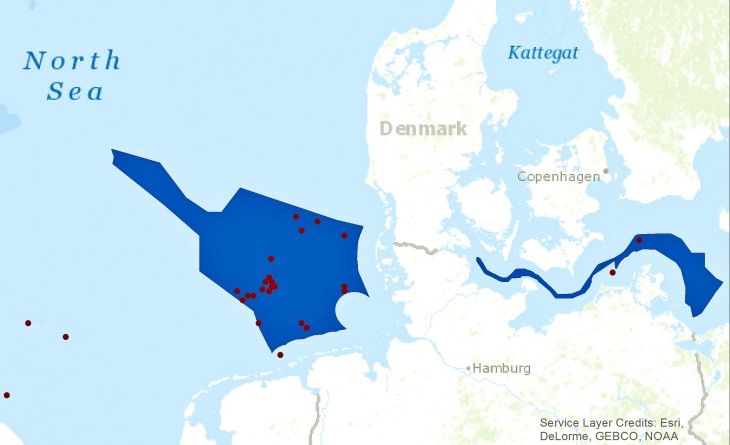
Offshore wind farms (red dots) planned with coastDat data in the North Sea and Baltic Sea; e.g. in the exclusive economic zone (EEZ) of Germany (blue). (Graphic: U.Kleeberg, E.Meyer / Hereon)
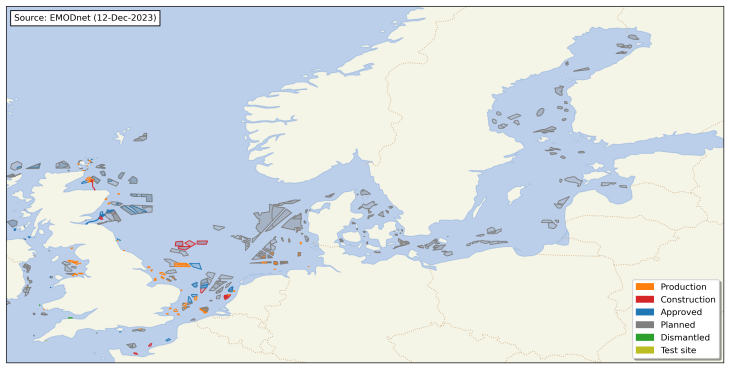
Offshore wind farms in North and Baltic Sea as listed at European Marine Observation and Data Network (EMODnet).(Graphic: E.Alizalde / Hereon)
The latter has been addressed in several Hereon studies using the coastDat database. For example, a climatology of wind energy over the North Sea was developed also considering potential synergies between different offshore wind farm arrays. In particular, met-ocean data from coastDat is used by nearly all planned and operated offshore wind farms in the German exclusive economic zone for optimization of design and logistics.
For futher information download the coastDat booklet.
The reduction of windspeed inside of windf arms and for neighbouring wind farms results in the reduction of the capacity factor. This leads to increases in energy production costs and economic losses and has to be taken into account in the planning phase.
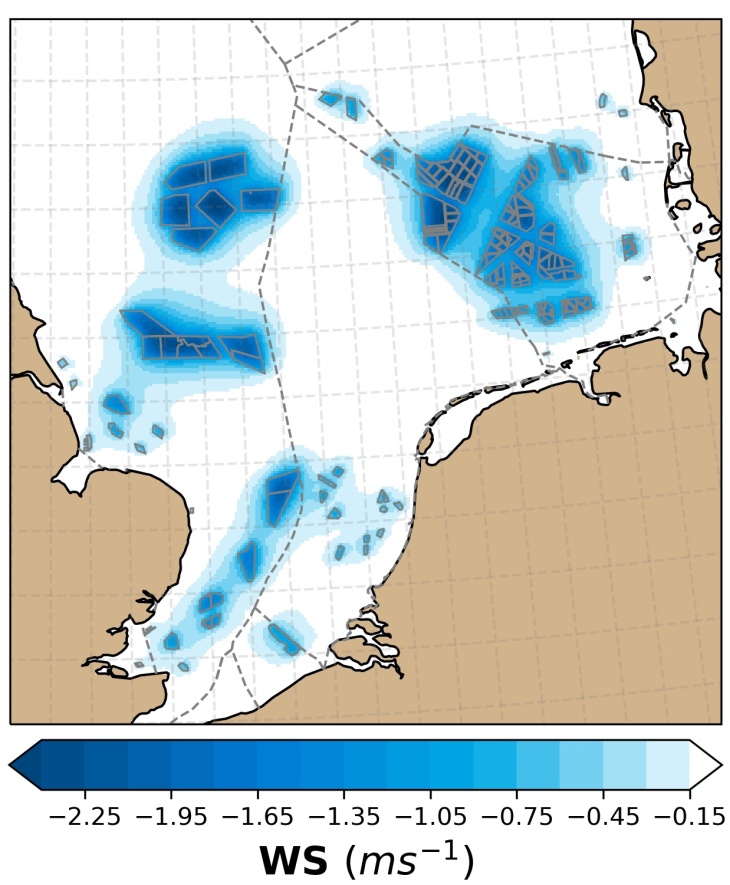
Reduction of windspeed at hub height due to windfarms. (Graphic: N.Akhtar / Hereon)
Publications
- Akhtar, N., Geyer, B., Rockel, B., Sommer, P.S., & Schrum, C. (2021): Accelerating deployment of offshore wind energy alter wind climate and reduce future power generation potentials. Sci Rep 11, 11826, doi:10.1038/s41598-021-91283-3
- Geyer, B., Weisse, R., Bisling, P., & Winterfeldt, J. (2015): Climatology of North Sea Wind Energy Derived from a Model Hindcast for 1958-2012. Journal of Wind Engineering and Industrial Aerodynamics, 147, S. 18–29, doi:10.1016/j.jweia.2015.09.005
- Weisse, R., Bisling, P., Gaslikova, L., Geyer, B., Groll, N., Hortamani, M. et al. (2015): Climate Services for Marine Applications in Europe. Earth Perspectives, 2(3), doi:0.1186/s40322-015-0029-0
Wind speed anomalies caused by wind farms of 150GW installed capacity modeled with a regional climate model: semi-transparent dark blue (-2 m/s) and brownish (+2 m/s) colors. The colors at the sea surface represent the changes in the latent heat flux. (Animation: A.Elizalde / Hereon, M. Böttinger / DKRZ)
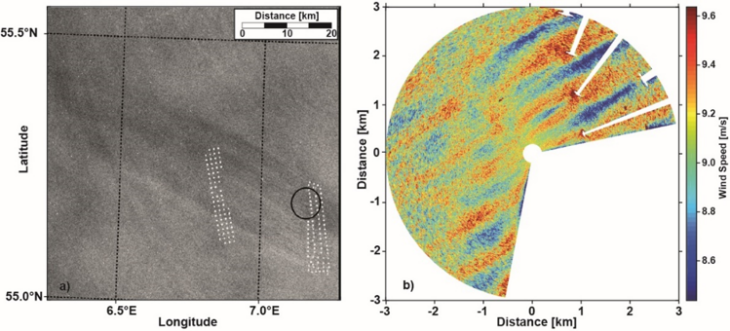
Sentinel-1 SAR image showing the large-scale wind wake of offshore wind farm DanTysk (left) and a wind field retrieved from Hereon’s marine radar in the area marked by the circle on the SAR image (Graphic: Jochen Horstmann / Hereon)
Wind turbines extract momentum from the wind field and add turbulence at the same time. The resulting wakes are visible in radar remote sensing data and show the dependencies of the wakes on the wind mill's size and height as well as farm size; the wakes scale up to hundred kilometers and more.
By comparison of synthetic aperture radar (SAR) data, acquired by the SENTINEL-1 and TerraSAR-X satellites, with profile measurements taken at the FINO-1 research platform, it was shown that the wake length increases with atmospheric stability.
Additional studies were performed to analyse the interaction of wakes originating from different wind parks in the German Bight and effects of single wind turbines on wind and friction velocity are observed with high spatial and temporal resolution using Hereon marine radars showing strong wind speed shear zones across the individual wakes.
Publication
- Akhtar, N., Geyer, B., & Schrum, C. (2022): Impacts of accelerating deployment of offshore windfarms on near-surface climate. Sci Rep 12, 18307 (2022), doi:10.1038/s41598-022-22868-9
- Djath, B., Schulz-Stellenfleth, J., & Cañadillas, B. (2018): Impact of atmospheric stability on X-band and C-band synthetic aperture radar imagery of offshore windpark wakes. Journal of Renewable and Sustainable Energy, Volume 10, Issue 4, doi:10.1063/1.5020437
- Vicen-Bueno, R., Horstmann, J., Terril, E., Paolo, T. de, & Dannenberg, J. (2013): Real-Time Ocean Wind Vector Retrieval from Marine Radar Image Sequences Acquired at Grazing Angle. J. Atmos. Oceanic Technol., Vol. 30, p. 127–139, doi:10.1175/JTECH-D-12-00027.1
- Emeis, S., Siedersleben, S., Lampert, A., Platis, A., Bange, J., Djath, B., Schulz-Stellenfleth, J., & Neumann, T. (2016): Exploring the Wakes of Large Offshore Wind Farms. Journal of Physics: Conference Series, 753:092014. IOP Publishing, doi:10.1088/1742-6596/753/9/092014
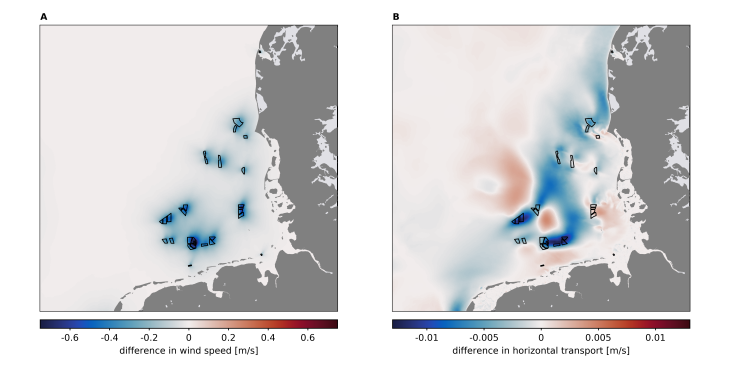
Changes in surface wind speed due to offshore wind farms (A) and their effects on the vertically averaged horizontal volume transport (B) on an annual average.
Harvesting energy from offshore wind resources reduces the wind speed downstream of offshore wind turbines. The resulting wind wakes influence the near-surface winds, which has an impact on wind-driven processes in the ocean such as surface currents, temperature exchange or mixing of the surface layer. For large-scale offshore installations, wind wake effects have been shown to lead to large-scale changes in horizontal transport and density stratification in the ocean, affecting regional hydrodynamics in shelf seas such as the North Sea.
Biogeochemical processes in the lower trophic marine ecosystem are strongly determined by the prevailing physical conditions. As a result, the hydrodynamic disturbances caused by wind wakes have a direct effect on ecosystem dynamics and influence, for example, vertical nutrient transport, primary production, or local biomass.
Regional and high-resolution models are used to study the effects of a modified wind field on the hydro- and ecosystem dynamics in the North Sea, including coupled physical-biogeochemical models as well as flexible unstructured-grid models.
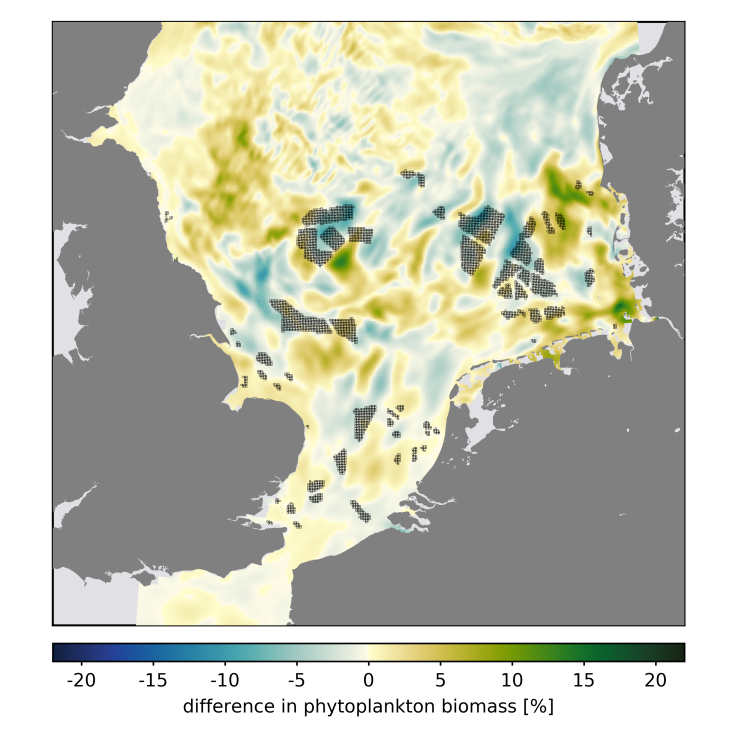
Relative changes in annually and vertically averaged phytoplankton biomass due to atmospheric offshore wind farm wakes.
Publication
- Christiansen, N., Daewel, U., Djath, B., and Schrum, C. 2022. Emergence of Large-Scale Hydrodynamic Structures Due to Atmospheric Offshore Wind Farm Wakes. Frontiers in Marine Science, 9. doi: 10.3389/fmars.2022.818501
- Christiansen, N., Daewel, U., and Schrum, C. 2022. Tidal mitigation of offshore wind wake effects in coastal seas. Frontiers in Marine Science, 9. doi: 10.3389/fmars.2022.1006647
- Daewel, U., Akhtar, N., Christiansen, N., and Schrum, C. 2022. Offshore wind farms are projected to impact primary production and bottom water deoxygenation in the North Sea. Communications Earth & Environment, 3: 292. doi: 10.1038/s43247-022-00625-0
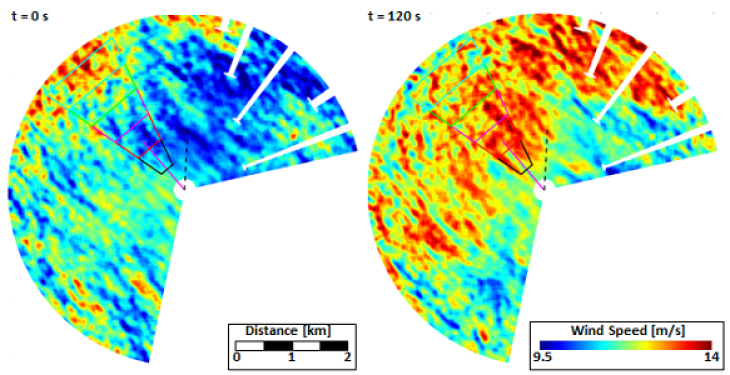
Surface radar retrieved wind fields (120 s apart in time) of a wind gust propagating towards the offshore platform Fino-3 in the German Bight (Graphic: Jochen Horstmann / Hereon)
For an improved predictive control of offshore wind farms, Hereon has developed a short-term (30 to 60 s) wind speed and gust prediction system. Wind fields are retrieved from marine radar image sequences to identify wind gusts and estimate their size and propagation speed and direction.
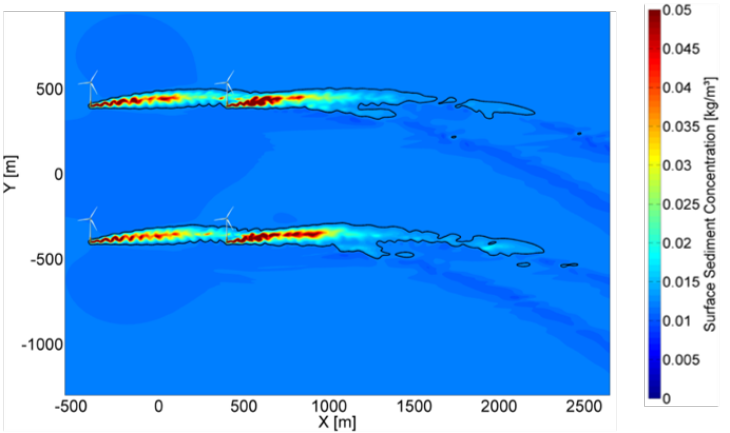
Snapshots for surface sediment concentration of suspended particle matter for a model basin with a depth of 21.6 m. (Graphic: Sebastian Grashorn / Hereon)
To study vortices generated by the piles of offshore wind farms, an unstructured grid ocean model (SCHISM) was applied. It was shown that the model is able to reproduce suspended matter concentration features, which were previously observed in optical satellite imagery.
By introducing turbulence in the water offshore wind farm piles can have a significant influence on the sediment dynamics. Higher t
urbulent energy behind the piles causes increased vertical mixing and hence can lead to higher concentrations of sediment near the sea surface.
This effect was successfully simulated using the unstructured grid model SCHISM run at Hereon. The model is well suited for this application, because it can resolve small scale processes in the vicinity of the piles using a finer computational mesh in that region. The vortices of increased surface sediment concentrations shown in the image are driven by tidal currents typical for the German Bight.
Publication

Turbulent velocity field in the wake of a cylindrical offshore wind farm structure. This is a snapshot from a Large Eddy Simulation looking from above on the water surface, with the current moving from left to right past the circular structure. Blue indicates a strong current, and red a weak current (Graphic: Jeff Carpenter / Hereon)
Ocean turbulence is caused by the interaction of tidal currents and the OWF structures. It provides an additional mixing potential for the seasonal stratification that forms throughout large areas of the German EEZ. In this way, large-scale OWF constructions can have a significant impact on North Sea stratification.
Current work is focused on understanding and quantifying the localised mixing process of a single OWF foundation using Large Eddy Simulations and in situ measurements. Initial results suggest that the low thermocline turbulence is expected to be enhanced by OWFs.
In addition to the high-resolution Large Eddy Simulations, regional ocean modeling is used to understand the impact of the mixing processes on North Sea stratification. By parameterizing the drag and turbulence generated from monopiles, recent work showed that foundation effects can extend far beyond turbine locations and influence summer stratification over large areas in the German Bight.
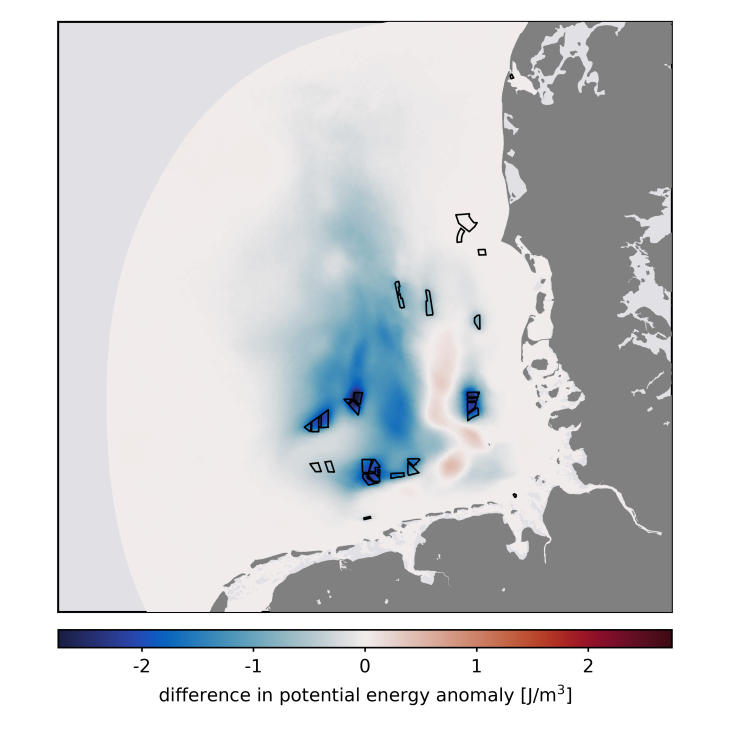
Changes in summer stratification due to induced turbulence from offshore wind farm structures in the German Bight. The potential energy anomaly is a measure for the intensity of the vertical density stratification of the water column.
Publications
- Carpenter, J.R., Merckelbach, L., Callies, U., Clark, S., Gaslikova, L., & Baschek, B. (2016): Potential Impacts of Offshore Wind Farms on North Sea Stratification. PLoS ONE, 11(8), e0160830, doi:10.1371/journal.pone.0160830
- Christiansen, N., Carpenter, J. R., Daewel, U., Suzuki, N., and Schrum, C. 2023. The large-scale impact of anthropogenic mixing by offshore wind turbine foundations in the shallow North Sea. Frontiers in Marine Science, 10. doi: 10.3389/fmars.2023.1178330
- Floeter, J., Beusekom, J.E.E. van, Auch, D., Callies, U., Carpenter, J.R., et al. (2017): Pelagic Effects of Offshore Wind Farm Foundations in the Stratified North Sea. Progress in Oceanography, 156, 154–173, doi:10.1016/j.pocean.2017.07.003
- Schultze, L.K.P., Merckelbach, L., & Carpenter, J.R. (2017): Turbulence and Mixing in a Shallow Stratified Shelf Sea from Underwater Gliders. Journal of Geophysical Research -- Oceans, 122, doi:10.1002/2017JC012872
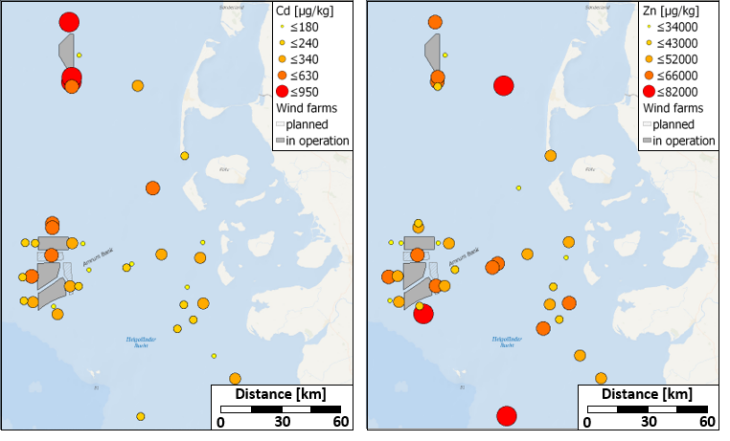
Initial results of mapping heavy metal sediment concentrations in the vicinity of wind farms and background reference areas in the German Bight. (Graphic: Ulrike Kleeberg, Daniel Pröfrock / Hereon)
The large-scale construction of offshore wind farms may have effects on the marine environment through introduction of new pollution sources. Examples are steel-reinforced foundations, scour prevention by geotextile sand containers, anti-corrosion measures (coatings, anodes) for pile protect, and activities related to regular maintenance.
Geotextiles used for scour protection around piles are permeable fabrics and mostly based on polyethylene or polypropylene. These fabrics typically contain plastic additives, such as plasticizers, UV-stabilizers, and flame retardants. Since additives are not chemically bound to the plastic material, they are leached by seawater and/or are accumulated by biota settling on the fabric after deployment.
Current research carried out in collaboration with the Federal Maritime and Hydrographic Agency also concentrates on possible pollution by sacrificial anodes and surface coatings used to protect offshore wind turbines against corrosion. Such investigations provide important information relevant for design specifications and the approval process for new wind farms by the Federal Maritime Agency.
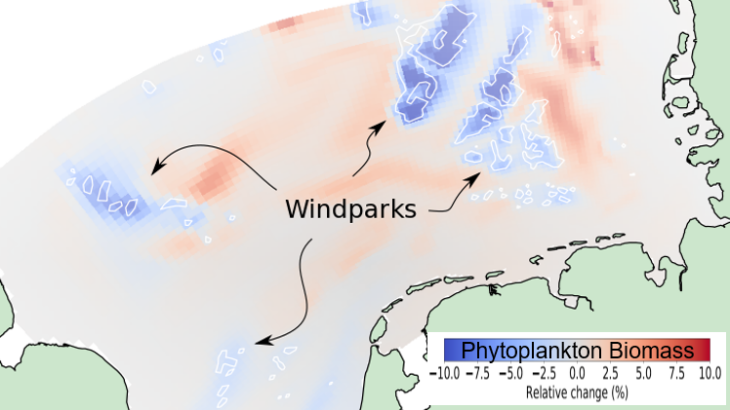
Simulated changes of phytoplankton biomass expected from epistructural filtration by the blue mussel mytilus edulis on newly created habitats on offshore wind farm piles. (Graphic: Carsten Lemmen / Hereon)
The build-up of offshore wind farms provides new hard surfaces in the water column that is a preferred habitat of the blue mussel (mytilus edulis). These blue mussels filter phytoplankton (algae) out of the water thus make the water clearer.
Computer simulations of the southern North Sea indicate how much clearer the water could be if all planned offshore wind farm piles were settled by blue mussels. An estimated 10 % of the algae are removed by the filtration from these epistructural blue mussels in or near the wind farms, and up to 10 % more algae are expected due to secondary effects, such as more nutrient availability leeward of the offshore wind farm areas.
Publication
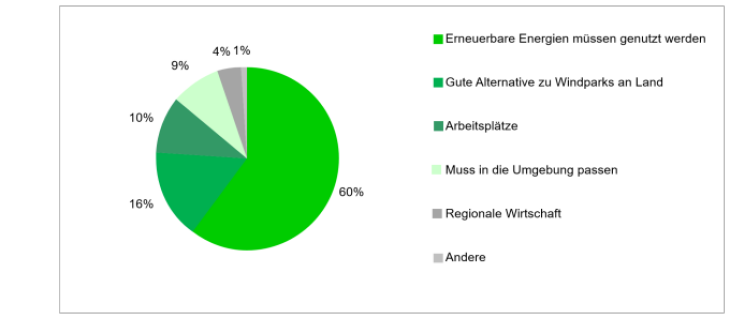
Arguments mentioned by local residents in support of offshore wind farms along the Wadden Sea coast in Schleswig-Holstein. (Graphic: Kira Gee, Andreas Kannen / Hereon)
A comparison of these arguments with the respondent's personal values, beliefs, and perception of the area, reveal different patterns of argumentation requiring various communication strategies by planners and investors within planning and approval processes.
Analyses of sociocultural perspectives of offshore wind farms thus support a better understanding of resistance, acceptance and support by residents and particular actor groups. Results are transposed by Hereon researchers into methodological proposals to improve marine planning and management, such as by outlining a concept for recognizing culturally significant areas, and into international training in Maritime Spatial Planning.
Publications
- Gee, K. (2013): Trade-offs Between Seascape and Offshore Wind Farming Values: An Analysis of Local Opinions Based on a Cognitive Belief Framework (pdf) PhD thesis University of Goettingen, p. 245
- Gee, K., Kannen, A., Adlam, R., Brooks, C., Chapman, M., Cormier, R., Fischer, C., Fletcher, S., Gubbins, M., Shucksmith, R., & Shellock, R. (2017): Identifying Culturally Significant Areas for Marine Spatial Planning. Ocean and Coastal Management, 136, pp. 139-147, doi:10.1016/j.ocecoaman.2016.11.026
